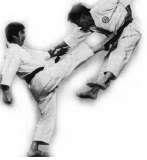Isn’t it strange how you think you know what something is only to realise years later that your understanding was a little superficial? There’s always more layers to everything isn’t there?
Kiai is a case in point. Back in April 2009 I wrote a post called Power of the kiai in which I quoted a definition of kiai as 'a projection of sound fused with energy or spirit'. Other people define it as a‘spirit shout’. Back then I just thought kiai was all about the shouting, a sharp exhalation of breath to tense the muscles and make your punches harder.
I understand kiai a little differently now. It isn’t a ‘thing’ that we do, i.e we don’t do a kiai as we punch; it isn’t merely a stylistic affectation for good effect. It is a part of us, something that we develop through hard training. We demonstrate kiai in the way we execute our techniques irrespective of whether we make a noise or not. Kiai is something that we see when we watch a student (if they have it) and not just something that we hear.
Many people will make a lot of noise but have no kiai, others will train silently but you will be left in no doubt that they have kiai in bucket loads. Kiai is also something you will feel in yourself when you have it.
So what am I talking about now?
According to Iain Abernethy in his book Bunkai-Jutsu, kiai is “…the convergence of all your energies at a single instant that ensure your goal is attainted….It is often accompanied by a loud noise, but simply shouting is not kiai.” He compares kiai to a loud explosion: “An explosion will make a loud noise, but a loud noise is not an explosion.”
The noise of kiai is simply the result of the outburst of energy as you deliver power to your target. It isn’t contrived. The important thing is the explosion of power to the target not the noise, though a scary noise might be useful too.
Kiai is something that starts off internal and becomes external as you execute a move. It is an outpouring of focus and concentration, grit and determination and a will to be perfect and precise. It’s as if you’ve charged up a battery inside of you and it’s discharging at full power.
I bet you’ve felt it: you’re practising a kata or standing in front of a punching pad/bag; you know an explosive burst is needed; you breathe in through the nose in preparation; you feel energised; then,wham – you execute that explosive movement with a sharp exhalation. You were blind to everything except the target; no other thoughts were in your mind; you wanted it to be the best most perfect move you’ve ever done – you had kiai…you were an explosion.
How do you develop kiai? According to Forrest Morgan in ‘Living the Martial Way’, you need to do five things: “find kokoro; practice haragei; develop kokyu chikara; apply kime and practice kata with utmost seriousness.”
Kokoro means ‘heart’, ‘mind’ or ‘essence’. It’s often interpreted as never accepting defeat, finding that indomitable spirit within – having the grit and determination to succeed. It’s about putting ‘heart and soul’ into your training.
Haragei. Hara = centre, gei = cultivation of, so haragei is the “cultivation of the centre of the self”. In other words, it is developing a proper awareness of where your centre of gravity is (2-3 inches below your navel) and knowing how to use it to good effect. To generate good technique you need to be rooted but agile. To generate kiai you need good technique. All techniques in karate require you to be aware of your hara.
Kokyu chikara means ‘breath power’. It’s about coordinating your breathing with the preparation and execution of techniques to maximise power.
Kime is about focus; physical, mental and spiritual focus. You focus your mind, body and intent on achieving your objective. You remain in the moment, you block out all other thoughts; you identify your target and aim precisely at it, focusing all your energy at one point.
So, to develop kiai we must put ‘heart and soul’ into our techniques, understand how to use the hara effectively, coordinate our breathing correctly and focus completely on our objective.
How do we train to develop kiai? Well, most people, including me, will say kata, kata, kata! Through a serious practice of kata we can learn to understand and develop the necessary attributes that lead to kiai.Warning! It takes year of training to achieve kiai..
Next time you are watching students train look for their kiai as well as listen….
Sue is the Blog-Editor-In-Chief for Martial News. You can contact her at sue.wharton@martialnews.co.uk Sue also writes a personal blog called My Journey to Black Belt


6 comments:
Outstanding post today, thanks Sue!
Thanks Charles ;-)
Hi, Sue, I assume by the avatar it is representative of embusen or is it enbusen. Have you done a post on it yet?
Hi Charles, it represents the 8 angles of evasion/attack. It's the emblem for a company called DFM (Directional Fighting Method) which owns Martial News.
Sue, only eight angles?
I think the dots and dashes mean something as well but I can't remember what! If you want a fuller explanation you could e-mail Martial News editor Phil Doherty (he's also chief instructor of DFM) at phil.doherty@hotmail.co.uk
Post a Comment